|
|
|
Equipment
|

Download This Page (306K)
|
|
Appropriate equipment and clothing are essential for a comfortable and safe outdoor experience. Generally, participants in our programs are expected to provide their own appropriate clothing, footwear and personal accessories. For important general information about these items see Technical Aspects Of Clothing below. Most of our programs meet in the morning, spend the day in the mountains, and return to civilization each evening. For some programs, especially when bivouacs or camping are involved, there are additional equipment and clothing requirements as detailed in the equipment list for each specific activity.
Rock Climbing Equipment
Ice Climbing Equipment
Mountaineering Equipment
Backcountry Skiing Equipment
|
|
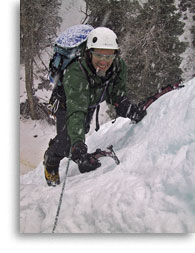
|
|
Equipment that works!
|
|
|
|
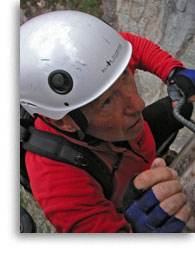
|
|
Gear evaluation, the fun way
|
|
Equipment That Works
We believe it is part of our job to be familiar with, and use, every piece of gear we can. For more than 25 years we have been in the enviable position of being able to extensively evaluate all kinds of climbing and skiing equipment in a hands-on setting. We don’t just go out for an afternoon and play with it – we take it out repeatedly, look for its shortcomings, and generally try to find out if it will stand up to the rigorous abuse of daily climbing and skiing in a professional setting. Over the years we have destroyed quite a bit of gear but, more importantly, we have developed some fairly strong opinions about what gear should do and which gear does it. This is the stuff we recommend – not the trendy gadgets designed mostly for “shelf appeal” or worse, designed to solve some “problem” that only exists if you lack essential skills. We have no use for frivolous gadgets or poor-quality knockoffs. All of the equipment we recommend has been thoroughly field-tested.
We have some equipment items available for you to try out during your program. There is no charge for this service and, by trying before you buy, you can be sure an item fits right and feels right under actual climbing or skiing conditions. Plastic boots are available on a rental basis. Don't buy a “pig in a poke”, try it first!
|
|
From time to time we replace equipment used in our programs with newer models. When available, this equipment is listed on our Gear For Sale page. For your convenience, while attending our programs, we also maintain a small selection of new equipment and books for sale.
|
|
Technical Aspects Of Clothing
In the mountains, the clothes on your back are sometimes the only form of shelter available. You won't find a warm building on the face of a remote mountain, so your comfort and safety may depend upon your clothing choices and your ability to use your clothing effectively.
Understanding Moisture & Heat
Managing Moisture & Heat
Natural Fabrics
Modern Fabrics
Clothing Systems
Fitting Clothing
Fitting Footwear
Accessories
Packing Your Gear
Purchasing Clothing & Footwear
|
|
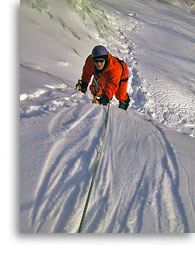
|
|
Clothing functions as equipment especially in winter
|
|
|
Understanding Moisture & Heat
Basic metabolic functions produce heat and moisture. One purpose of outdoor clothing is to retain enough heat for comfort but not enough to overheat. When your body is too warm, due to the environment or physical activity, it will sweat in an attempt to cool itself through evaporation. This works great when your perspiration can evaporate on, or close to, your skin and cool you to a comfortable temperature. However, in some mountain environments, your body’s attempts at evaporation may be thwarted by the need to protect yourself from wind, rain, snow or cold temperatures. You perspire, but your protective clothing prevents the perspiration from evaporating, and the moisture stays in your clothing instead. If you can’t get rid of this moisture it will accumulate and eventually your wet clothes, instead of keeping you warm, will conduct heat away from your body. This conductive heat loss accomplishes the same end result as evaporative cooling but, unlike evaporative cooling, which stops unless you continue to add perspiration, conductive cooling will continue until the wet clothes are removed. In cool or cold conditions, conductive heat loss can continue well past the point where you are comfortable – in fact, it can result in hypothermia. If you avoid overheating in the first place, and your clothes never become wet, you don’t have to worry about this problem. If you do overheat, modern synthetic fabrics can help move the extra moisture away from your body through the process of wicking.
|
|
Managing Moisture & Heat
Awareness & Action
Always remember, the single most important thing you can do to stay comfortable in cool or cold conditions is to avoid overheating in the first place! In winter, many people, worried about getting cold, over-insulate themselves by putting on too much clothing. Ironically, they overheat, get wet, and end up cold – because they overdressed! If you are aware that you are getting too warm, you can eliminate excess heat and moisture by venting or removing a layer before you overheat. Likewise, when you feel yourself getting cold, add a layer. It’s far better to be under-dressed, and slightly chilly, than overdressed and overheated. Experienced alpinists make frequent adjustments to their clothing systems (opening/closing zippers, adding/subtracting a hat, etc.) to maintain comfort and, except when they are inactive, they are often dressed lightly.
|
|
Natural Fabrics
Man has always employed natural materials for protection against the elements. Animal skins made it possible for people to survive in cold climates and, even today, leather is an excellent material for certain applications such as boots and gloves. Cotton and wool have provided fabric for clothing since man first learned to process these materials and they still account for much of the clothing made today. They have advantages over modern synthetics in some cases but they also have some serious limitations.
|
|
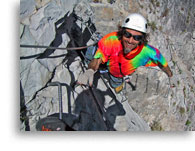
|
|
Cool cotton on a hot day
|
|
|
Cotton
Inexpensive and comfortable, cotton is a great hot weather fabric. Its ability to facilitate evaporative cooling makes it most pleasant to wear when your goal is to get rid of heat. When it comes to retaining heat however, cotton stands out as being spectacularly ineffective. Because, when it absorbs moisture, cotton has no wicking ability and no insulating ability, it is foolish to wear any cotton at all when your goal is to stay warm. The well-known expression “cotton kills” is a good one to keep in mind when you are dressing for cool or cold weather. We often wear cotton shirts, but only on hot days.
Wool
Until relatively recently, wool was the only readily available fabric suitable for active use in cold weather. Most of the world’s great mountains were first climbed by people wearing wool! Wool is a good insulator – even when it gets wet – so it will work reasonably well in cold weather. However, when compared to synthetics, wool has some serious disadvantages. The biggest drawback to wool is that it does not transport moisture by wicking – once it gets wet, wool stays that way. Even in a warm room, wool is slow and difficult to dry. Compared to synthetics, wool is very heavy, it has very little elasticity, and its coarse feel against the skin irritates many people. Most people find synthetics much more comfortable. Wool also requires special laundering care, it’s expensive, and moths love to eat the stuff. Finally, when wool is wet you smell like a sheep! Considering all of the above, it’s not hard to understand why synthetics have largely replaced wool in the mountains. Today, 100% wool is completely absent from our mountain wardrobe and, even when blended with synthetics, it has very limited application for active alpine sports.
Goose Down
Good quality down is a superb, lightweight insulator – when dry. Unfortunately, it does not wick and if it is exposed to moisture, from inside or out, it rapidly loses its insulating ability. On cold, but sunny winter days, when it can be kept reliably dry, we sometimes carry a down jacket for instant warmth during periods of inactivity. We also use down sleeping bags if we are sure they will stay dry.
|
|
Modern Fabrics
Before you run out and buy the latest high-tech garment, it is important to realize that some environments and activities benefit greatly from modern clothing technology – and others are largely unaffected. When your adventures take you to wet, windy and cold places, modern technology can make a big difference in your comfort and, in extreme cases, your safety. Beyond the synthetic fabrics described below, there are many others designed to have special qualities such as abrasion resistance, light weight, or a soft feel. These qualities may, or may not, have an impact on heat and moisture. We often wear special abrasion-resistant fabrics while climbing.
|
|
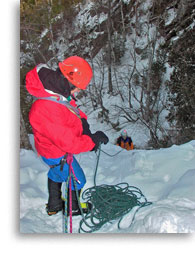
|
|
High tech comfort
|
|
|
Moisture Transport Fabrics
Modern fabrics perform many functions and wicking is among the most important. Wicking is the tendency for certain fabrics to transport moisture away from your warm body so it can evaporate far from your skin. Fabrics that wick absorb very little water – instead, water (in liquid or vapor form) is transported through the fabric. Because they move moisture, wicking fabrics allow you to perspire, to some extent, without becoming soaked. Profuse sweating, due to serious overheating, will dampen these fabrics but they will continue wicking, and thus dry out, once you stop sweating. This allows you some margin for error when it comes to venting and removing layers to avoid overheating.
Wicking fabrics, generally derived from polyester, are sold under many trade names and marketed for many specific applications. When first marketed, in the 1970’s , these fabrics used to be called polypropylene. Nowadays, much improved synthetic formulations have been developed. Lighter weight versions of these fabrics are usually sold for use as underwear – their primary function being to move moisture away from the skin. Medium and heavy weights of these fabrics are also sold as underwear but they can also be insulating layers, often worn on top of underwear. Every manufacturer seems to have a reason why their particular fabrics work best, and there are subtle differences between different incarnations, but the important thing to remember is that all of these fabrics will help keep you warm and dry infinitely better than natural fibers. We wear these fabrics any time we are active and temperatures are not hot.
|
|
Insulating Fabrics
Insulating fabrics are designed to retard the flow of heat away from your body. They mostly do this by creating a dead air space. Like wicking fabrics, these materials are essentially plastics that have been turned into clothing. The most common insulating fabric used for active sports is generically called fleece. All fleece, in addition to insulating, will do quite well at moisture transport. Fleece comes in a dizzying array of varieties! It is available in many weights, from very thin to very thick. It can be cut – most fleece is – or uncut, which results in a fabric that is very warm and fuzzy (and makes the wearer look a bit like a bear). It can be blended with elastics to be stretchy or have a membrane added to make it windproof. Because fleece insulates and wicks, it is extremely versatile and, every alpinist should own at least some fleece. Except on very hot days, we never go out without fleece. Fleece even works great around the house or office – I am wearing fleece pants and a fleece pullover as I write this!
Shell Fabrics
Designed to keep wind and water out, these fabrics are worn as your outermost layer – your shell. The lightest shells are typically made from gossamer-thin nylon, will pack into almost no space at all, and are just windproof – not waterproof. These shells breathe very well and are very useful in some conditions, but to effectively keep out water, some type of coating or membrane must be added to a shell. The least expensive waterproof shells are not breathable. Even though they keep rain and snow out, they will also trap moisture inside so you end up wet anyway. To avoid this problem, the best solution is a shell that is both waterproof and breathable. Waterproof/breathable technology has evolved tremendously since the days when leaky garments, that barely breathed, were the rule. All modern “hard shells” should be completely waterproof, but some will breathe considerably better than others. None, however, will breathe nearly as well as a layer that is just windproof. Remember that.
We generally prefer fabrics made waterproof/breathable by coating, rather than with membranes. Typically, coated fabrics are less expensive than the ones with membranes, but may perform just as well. We also prefer simpler, lighter weight shells unless we are in an environment where abrasion resistance is important.
In addition to the traditional “hard shells” described above, high-tech fabrics have enabled manufacturers to produce “soft shells”. These fabrics blend some of the characteristics of insulating fabrics with some of the characteristics of hard shell fabrics and they are extremely functional and comfortable under certain conditions. We wear a soft shell whenever conditions permit during winter.
On dry, calm summer days we rarely wear a shell at all. If the wind picks up we often wear just a windproof shell. When rain is likely we usually wear or carry lightweight, waterproof/breathable shells.
Sunny, windless, winter days are perfect for a soft shell or, if it's really warm, no shell at all. When rain, wind or frigid cold is likely we usually wear or carry lightweight, waterproof/breathable shells to pullover our soft shells. And, on the rare occasions when conditions are truly fierce, we grab our heaviest waterproof/breathable hard shells (or stay inside!).
|
|
Clothing Systems
Layering – The Key To Comfort
In mountain environments, most effective clothing systems consist of several layers. A wicking layer, directly against the skin, moves moisture into the next layer, the insulating layer. Often, the insulating layer actually includes several layers which can be added or removed according to conditions. Modern insulating layers not only provide warmth, they also continue to move moisture away from the body by wicking. Multiple light layers, that can be added or removed according to conditions, are far more versatile than a single heavy layer. Finally, an outer layer may be used to seal out moisture and wind, while letting vapor escape. An extra layer or two should usually be carried in case conditions are not what you expect.
|
|
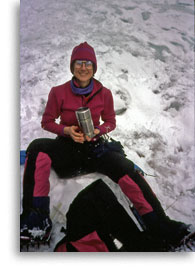
|
|
Shedding layers for a sunny lunch
|
|
|
Clothing Systems For Hot Weather
The goal here is generally to stay cool. A short-sleeved, cotton t-shirt and comfortable shorts, or cotton tights, will work on the hottest days. Synthetic fabrics, designed to facilitate cooling, can be used in place of cotton. Add long, lightweight pants to protect your legs from scratches while climbing and a long sleeve shirt for further protection if you’re climbing big cracks or chimneys. Carry a windproof shell and/or a light insulating top – just in case.
Clothing Systems For Mild Weather
In temperate weather you can sometimes almost ignore your clothing – until conditions change. Long pants made from rugged, stretchy fabrics combined with a zip-turtleneck shirt of wicking fabric and a light insulating layer often make a good combination. Once again, carry extra layers – just in case.
Clothing Systems For Cold Weather
The challenge in cold weather is to stay warm without overheating. Start with a wicking layer on top and bottom. A zip turtleneck top allows for easy venting of excess heat and moisture. Activity level, and your metabolism, will dictate how many insulating layers are required. These layers may include a range of fabrics and weights, and you will need to do some experimenting to find what works well for you. An outer shell is essential for nearly all winter activities so you can come into contact with snow or ice without getting soaked. Because one-piece shells make it impossible to vent by removing just your top, we suggest you choose pants (or bibs) and a jacket (or anorak) instead. On sunny, warm winter days we sometimes remove our jackets but, with the added encumbrance of gaiters and a climbing harness, making adjustments to pants is impractical, so don’t worry about full side-zips. Soft shells are great when conditions are not extreme. Waterproof/breathable fabrics are ideally suited for use as winter shells when conditions get nasty. Unless conditions are horrendous, we prefer lighter weight shells over heavier ones because they are more comfortable and less bulky.
Head, Hands & Feet
Often, a climbing helmet can be worn without a hat. As temperatures drop, a fleece headband or liner hat, can make a big difference – under your helmet, or worn alone. A fleece neck gaiter adds extra warmth. A baseball cap works great to shade your eyes when a helmet is not required.
In cool or cold weather, we often carry lightweight fleece gloves in addition to the specialized ones (see equipment list for each activity) we wear while climbing or skiing. In warm weather we wear a single thin sock, or no socks at all, for roadside rock climbing. For longer, or more remote objectives, we wear medium-weight synthetic socks designed to wick moisture. These thicker socks, in addition to wicking, provide extra cushioning and comfort. In cold weather, we wear a single, heavy, terry-loop sock designed specifically for winter. These socks incorporate wicking and insulation in a single layer. We no longer wear liner socks because they bunch up and cause blisters – and, with a modern sock, they are completely unnecessary.
|
|
Fitting Clothing
Climbing and skiing require clothing that allows unrestricted movement. Well-made clothing will often employ complex fabric cuts and some capacity to stretch with the wearer. Overly bulky or baggy clothing may catch in gear while climbing, or snag on trees while skiing, but some layers need to be sized large enough to fit over others. When you try on clothing, make sure it does not restrict any possible movement you might make while climbing or skiing. Sleeves too short (or long), necks too tight (or loose), hoods that won’t allow you to turn your head, or any of countless other fit problems can seriously compromise any piece of clothing so, if it doesn’t fit, don’t buy it. A garment with every feature you ever wanted, in your favorite color, at a bargain-basement price, isn’t any good if you can’t actually wear it comfortably.
|
|
Fitting Footwear
The fit of a shoe or boot is determined as much by its shape as its size. A perfectly fit shoe would match the outline of your foot exactly – in all three dimensions. The size tells you how long the shoe is but, even if width is specified, you really don’t know if it will be the right width and height for all parts of your foot – unless you try it on. Every foot is shaped differently and each manufacturer shapes their footwear in a particular manner. If one company’s lasts (foot shapes) fit you well, you will likely find another’s fit poorly. Your job is to figure out who’s lasts fit your feet best. If you settle for a sloppy fit you will sacrifice performance — much more so than would be apparent in street shoes. A perfect fit is not always possible, but a good fit is not an unrealistic goal. Because the fit of climbing and skiing footwear often has a huge impact on its performance, we provide specific fit information in the equipment list for each of our activities. Fitting climbing and skiing boots or shoes by mail involves immense compromise in the fitting process and we suggest you avoid this practice if at all possible.
|
|
Accessories
Sunglasses protect your eyes from the sun as well as dust, tree branches, ice chips and all sorts of other annoyances. Impact-resistant lenses made from polycarbonate, or something similar, are the best and polarization is very helpful – especially when near snow or water. Glacier glasses, with very dark lenses, work well in the brightest conditions but they may be too dark for average sun. Side-shields are good but, be sure they are easy to remove or, you may find fogging is a problem sometimes. If you already wear eyeglasses, visit your optician and have prescription sunglasses made. Quality sunglasses are an investment, so get a good case and a retainer so they won’t fly off. While we are on the subject of sun, get a good sunscreen (at least SPF 15) and apply it often.
Water is essential for active sports and it can be carried in several ways. A wide-mouth plastic bottle is great in the winter when freezing is possible, but we prefer to carry water in a rugged collapsible plastic bag that can be placed in our pack. If you drink lots of water, and you are willing to carry it, a bladder system in a pack, with a hose, will allow you to drink often – even while you are actively climbing or skiing. Most people, who start the day well-hydrated, will find one liter is adequate for a typical day of moderate activity in comfortable to cold conditions. Considerably more may be needed for very active or hot days. In winter we carry hot herbal tea in a thermos. To purify water from streams or springs, we carry a tiny bottle of crystalline iodine (not tincture of iodine). This method is far more convenient than filtration. If you are allergic to iodine (or shellfish), you will need a filter instead.
A small pocket knife, or multi-tool, is handy for cutting up fruit at lunch and other tasks. A watch, with an altimeter, is very handy for tracking progress on a big climb. Add a map, compass and GPS and you will know your exact location when you venture off the beaten path. A butane lighter, or other fire-starter, is a sensible precaution when you are away from civilization. Someone in every group should have a first-aid kit – and the knowledge required to use it!
We rarely go out without a camera. Our small digital cameras fit into a shirt pocket and offer lots of storage capacity for photos. A small camera that is with you is far better than a larger one that sits in the car because it gets in the way when you are climbing or skiing. We often provide our clients with copies of digital photos we take of them during our programs.
|
|
Packing Your Gear
We usually carry some sort of pack when we are in the mountains. A small fanny pack, with a wind shell and water, may be enough in some circumstances, but many situations call for extra clothing, food, and other items. Sometimes we carry a pack to the base of a cliff and pick it up after the climb, and sometimes we wear a rucksack or a medium-sized fanny pack while climbing or skiing. What to carry, and how to carry it, are important decisions that must be made for every outing. We always strive to carry as little as possible, while still being reasonably well prepared for the unexpected. Weather and itineraries have a habit of changing, so it’s best to have a variety of clothing, equipment and packs to choose from when the time comes. Equipment lists for each activity will give you more ideas.
|
|

|
|
Carrying just what you need
|
|
|
Purchasing Clothing & Footwear
We purposely avoided mentioning specific manufacturers or products in the preceding sections. This is because there are vast numbers of similar products from many manufacturers. Most of these companies have put a great amount of thought into their products but, because every manufacturer has different ideas about how to tailor their clothing (and alterations are usually difficult or impossible) there is a very good argument in favor of trying on that $400 jacket before you buy it! Visit specialty retailers until you find a manufacturer whose clothes are cut to fit your body. We realize that mail-order shopping (over the web or by catalog) usually provides the best selection and price, but how much of a bargain is that discounted jacket (in your favorite color, to boot) if you end up giving it to your brother-in-law because it fits him but not you? If, instead of filling your brother-in-law’s wardrobe, you choose to return clothes for a better fit, you may find your savings more than offset by the shipping costs and hassle. If you already own items that fit well, and you see a great deal on clothes from the same company, it might be worthwhile to order them. By the way, you might wish to consider that bright colors – the ones that stand out from the drab colors of rock, ice and snow – often make the best mountain photographs. You don’t need to dress like a Christmas tree, but a touch of color really makes a big difference. The following handful of companies manufacture quality outdoor clothing and footwear. Their web sites and catalogs contain a wealth of information which can serve as a good starting point as you explore clothing and footwear technology. Most of these sites provide information about their dealers.
Clothing Companies
Arc’teryx
Cloudveil
Columbia
Granite Gear
LL Bean
Lowe Alpine
Marmot
Mountain Hardware
Patagonia
The North Face
Wild Things
Footwear Companies
Boreal
FiveTen
Garmont
Koflach
La Sportiva
Salomon
Scarpa
|
 |
 |
 |
 |
|







